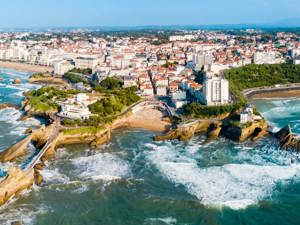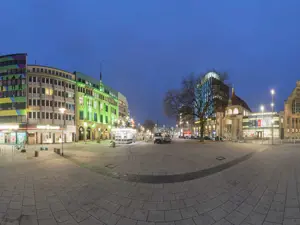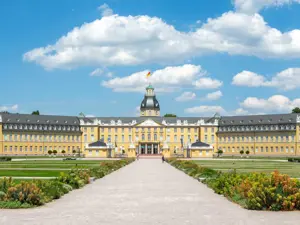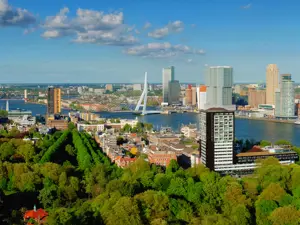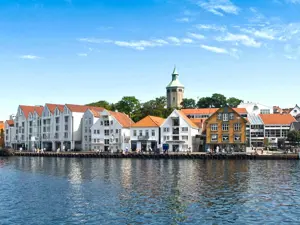The Little Vienna, or the city of flowers and parks
Timisoara is situated in the west of Romania, near the border with the former Yugoslavia, not far from Hungary and 600 km from Bucharest. It is home to an international airport, which has lately become the most important after Bucharest with flights to all the main Italian and European airports.
From a small fortified town dating back to 1212, known as “Castrum Temesiensis”, Timisoara has today become the largest city in western Romania with almost 400,000 inhabitants.

Timisoara. Editorial use photo: Copyright © Sisterscom.com / tony4urban / Depositphotos
Capital of the region of Banat, it has made giant strides forward. “Little Vienna” or “the city of flowers and parks” are two names for Timisoara that reflect two important aspects of the city: the architecture is very similar to Vienna and the numerous parks give the urban centre a pleasant, welcoming character.

Timisoara. Editorial use photo: Copyright © Sisterscom.com / Krasnevsky / Depositphotos
Timisoara can boast the largest centre of historic buildings in Romania. Because of the long Hapsburg nomination, but also thanks to its proximity to western Europe, it is also the most cosmopolitan city in Romania and an excellent example of cohabitation between peoples. It features Orthodox and Catholic churches and cathedrals, and restaurants and bars in which Romanian, Hungarian, German, Serbian and Italian are spoken. Over the last few years, thanks an excellent local policy, the city has attracted thousands for foreign business people, mostly Italians. The presence of many universities, theatres and museums give the city a vibrant cultural life.
The squares of Timisoara
Freedom Square (Piata Libertatii) is considered the heart of the city, the topographical centre. It is located at the crossroads of several old roads which preserve visible traces of the past, but are also the heart of the city’s night life. Union Square (Piata Unirii) is one on the most beautiful in Romania. It is entirely pedestrianised and features a large park surrounded by beautiful brightly coloured buildings in Baroque style with decorative elements around the cornices, windows and doors.

Timisoara. Copyright © Sisterscom.com, Shutterstock
In the centre of the square stands the Trinity Column, erected in 1740 following the plague of the previous year. On the west side of the square stands the Serbian Orthodox Bishop’s residence, with a beautiful façade built in Baroque-style with oriental influences and painted in green. On the east side is the Catholic Cathedral, a Baroque building built between 1737 and 1773.
The Banat Museum, on the south side of the square, is also very interesting (open from Tuesday to Sunday from 10 am to 4.30 pm). Founded in 1872, this museum is housed in a fourteenth-century fort built by the house of Angiò and rebuilt the following century by Prince Iancu de Hunedoare, the father of the King of Hungary Matthias Corvinus.

Timisoara. Copyright © Sisterscom.com, Shutterstock
A series of monuments can be found near Piata Unirii which are well worth a visit. Among these are the Merciful Church with adjoining hospital, an eighteenth-century Baroque building; the synagogue built in Moorish style in 1863; the house of Eugene of Savoy built in the eighteenth century and the Serbian Orthodox Cathedral dating back to 1734.
The Banat Village Museum is found in Padurea Verde (Green Forest) in the north-east of the city. This open-air museum exhibits more than thirty peasant homes from different areas of the region dating from the nineteenth century.
Text by Eugenio Sorrentino
Update by Alisè Vitri
Avion Tourism Magazine
Photos: Sisterscom.com, Shutterstock
Copyright © Sisterscom.com
Tourist Offices
www.timisoara-info.ro
www.romania.travel
Partnership with Booking.com
Where to sleep in Timisoara

Timisoara. Copyright © Sisterscom.com, Shutterstock
Timisoara is a welcoming city and offers different possibilities for accommodation.
To find the ideal hotel and the best offers you can do a search for the stars but also for districts or landmarks.
DISTRICTS
Hotels in the districts
LANDMARKS
Hotels in tourist areas
WHERE TO GO in Timisoara
Monuments in Timisoara

Copyright © Sisterscom.com, Shutterstock
ROMANIAN ORTHODOX METROPOLITAN CATHEDRAL
The Cathedral was built between 1936 and 1946 in Victory Square with green and red tiles arranged in a mosaic design. A monument dedicated to those who lost their lives during the 1989 Revolution is situated in front of the cathedral.
THE ROMAN CATHOLIC CATHEDRAL
The Roman Catholic Cathedral was built between 1736 and 1754 by Fisher von Erlach and is an excellent example of Viennese Baroque style. The main altar was completed by Michael Angelo Unterberger, director of the Fine Arts Academy in Vienna.

Copyright © Sisterscom.com, Shutterstock
UNIRII SQUARE
It is the main square of the old town of Timişoara and is one of the most picturesque places in the city. “Unirii“ means "Square Union", because the two cathedrals (Catholic and Orthodox) overlook on opposite sides of the square and represent the peaceful coexistence between the two major religions of the country.
Museums in Timisoara

Copyright © Sisterscom.com, Shutterstock
BANAT MUSEUM
The Museum, situated in a fifteenth-century castle, offers one section devoted to history and another to natural history.

Copyright © Sisterscom.com, Shutterstock
MEMORIAL MUSEUM OF THE 1989 REVOLUTION
The Memorial Museum exhibits the uniforms of Romanian military, written testimonies of participants of the Revolution, official and personal documents, an audio-visual archive, a library and a collection of newspapers.

Copyright © Sisterscom.com, Shutterstock
TIMISOARA ART MUSEUM
The collection of the Art Museum of Timisoara includes works dating from the fifteenth to the seventeenth centuries by Italian masters and European artists.
Excursions in Timisoara

Copyright © Sisterscom.com, Shutterstock
BANAT VILLAGE MUSEUM
Is an open-air museum, situated 3 miles from the city centre, that exhibits more than 30 traditional rural houses dating from the nineteenth century. Craftsmen's fairs and folk shows are held here periodically.

Copyright © Sisterscom.com, Shutterstock
HERCULANE SPA
Is one of oldest thermal spas in the world. Legend says that Hercules cured the wounds inflicted by the Hydra after bathing in the mineral springs of this area.

Copyright © Sisterscom.com, Shutterstock
RECAS VINEYARDS
A visit to these vineyards includes a presentation of the wine-making process in barrique barrels, and the conservation of the wines in bottles in the cellars featuring exceptional wines. The visit also includes tasting of white, red and rosé wines such as Cabernet Sauvignon, Burgund Mare and Merlot. It is located approximately 20 km from Timisoara.
RETEZAT NATIONAL PARK
Nestled in one of the most beautiful mountain ranges of Romania, Retezat National Park is characterized by some of the highest rocky peaks (such as Retezatu and Peleagu, both more than 8,202 ft. in height) reflected in a set of over 80 clear glacial lakes. A hiker's paradise, Retezat became Romanian's first national park in 1935 and, later, a biosphere reserve.
Partnership with GetYourGuide
Discover all tours
Luxury
You might be interested in
Other destinations
Airports nearby Timisoara





















